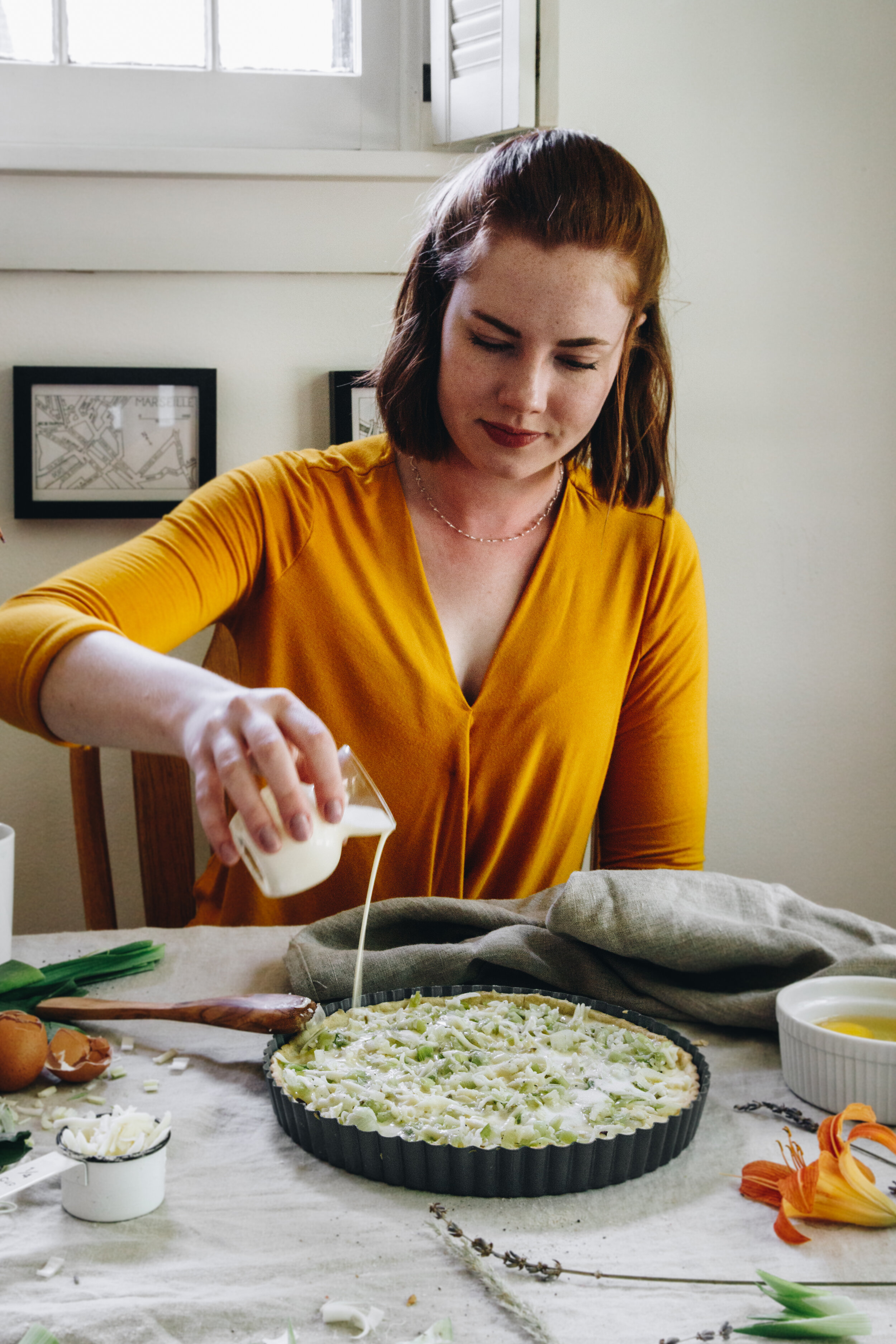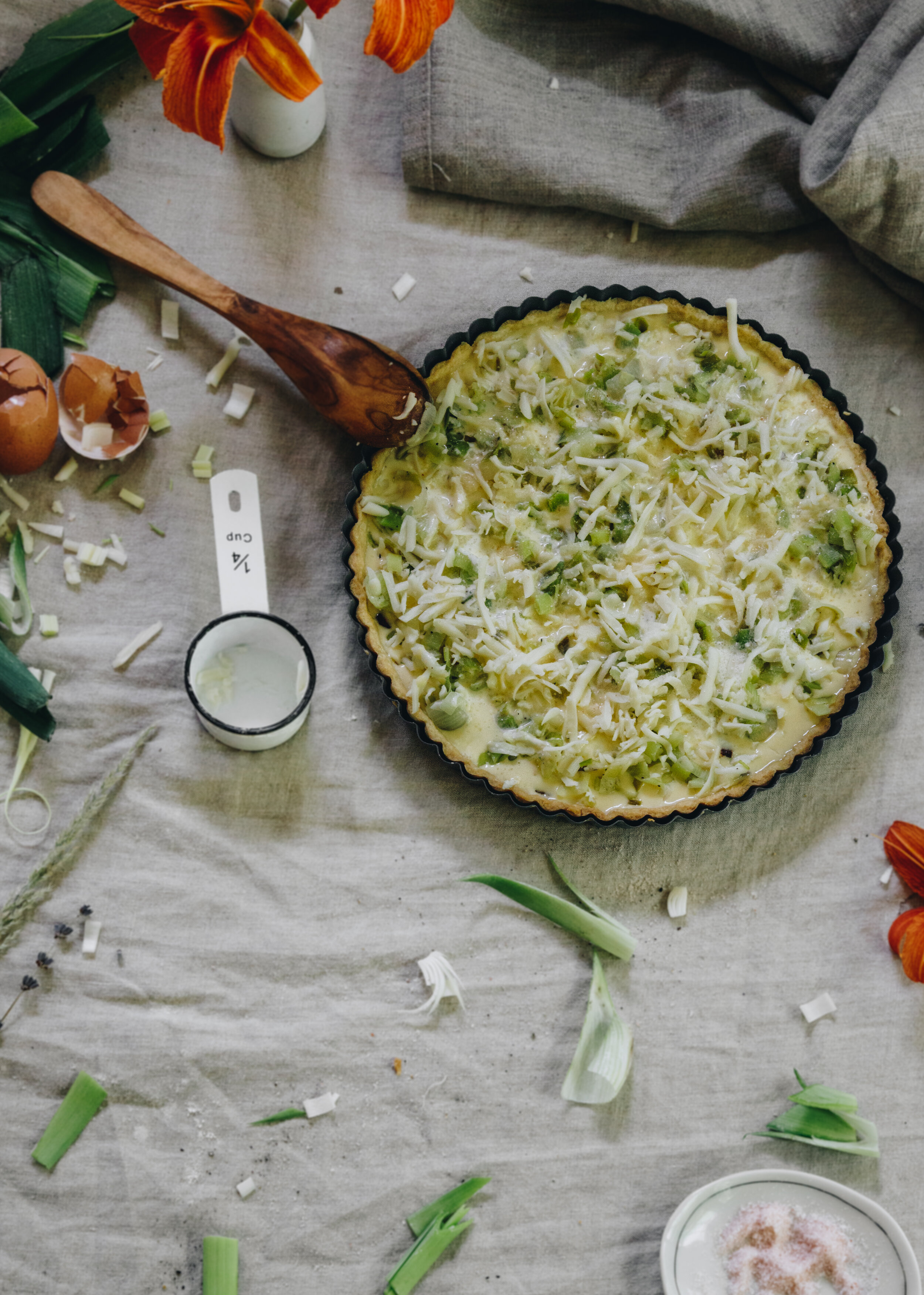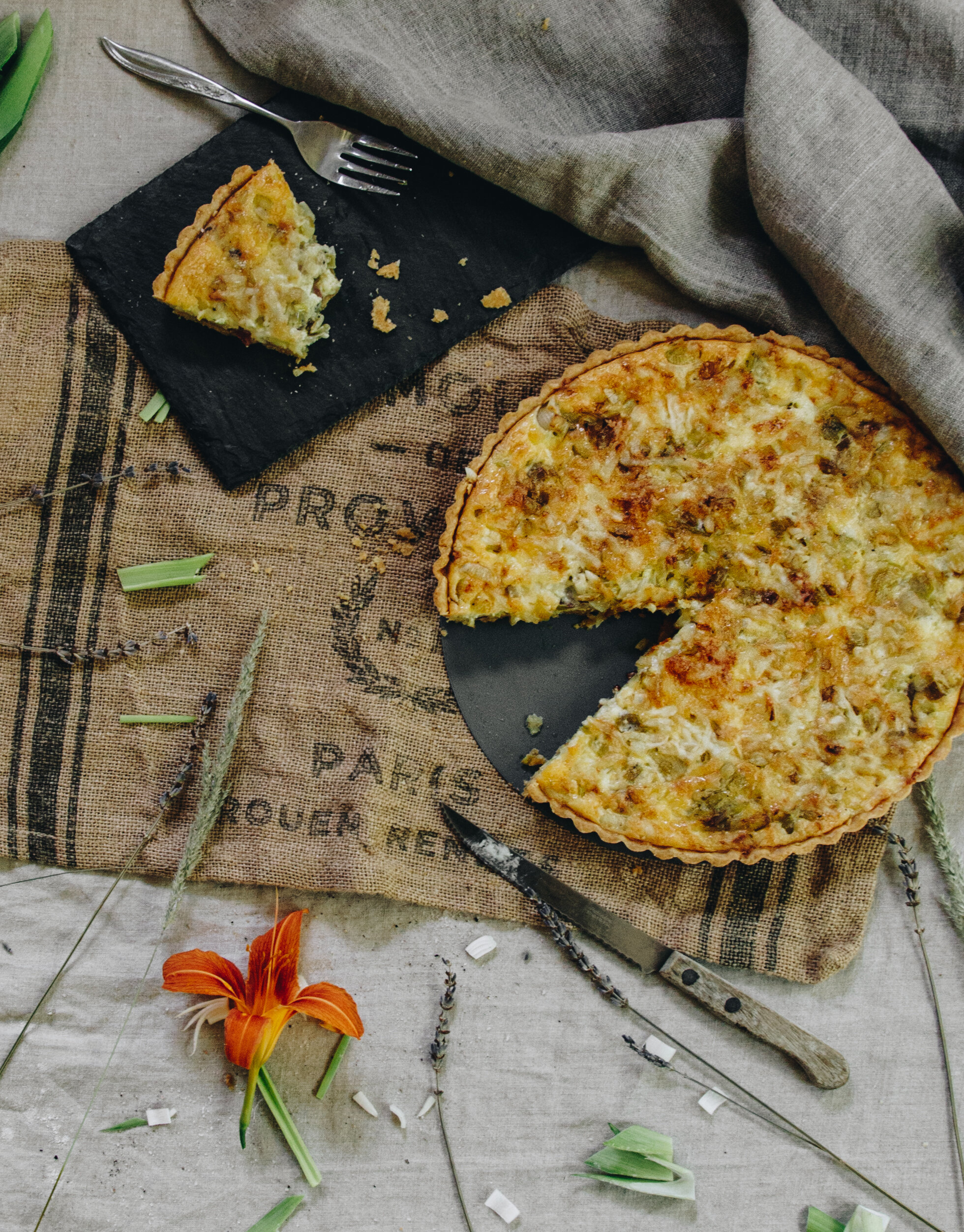Building a Better Food System (and Bacon & Leek Quiche Lorraine) with Amanda Koehler
The powerhouse food policy organizer breaks down the fight against factory farming and systems of oppression in our food system— and why you need to join this movement
Story + Photography by Sarah Carroll
Recipe shared by Amanda Koehler
This is not a normal day for Amanda Koehler. Today, instead of advocating at the state capitol, meeting with farmers across the state, or strategizing how to pass policies to strengthen Minnesota’s food and farming system, Amanda is standing in my kitchen, pressing rich buttery dough into a pie form.
The force-of-nature State Policy Organizer for The Land Stewardship Project, fierce food system advocate, and candidate running for the Minnesota House of Representatives spent a day sharing her family recipe for Quiche Lorraine, with ingredients sourced from some of her favorite local farms, while we talked about organizing for democratized farming communities, stopping new factory farms, and what it really takes to build power for food system change. Amanda’s one to watch, and her interview is one to read, especially while digging into a slice of quiche pulled straight from the oven (recipe below).
Sarah: Amanda, tell me about what you do and what a day in your life is like.
Amanda: I organize with family farmers and rural Minnesotans around sustainable agriculture, democracy, local control, and making sure communities have a say in things that impact them every single day for The Land Stewardship Project. We organize around creating a sustainable and just farm and food system.
I get people’s voices together in one room to talk about how we are going to build people power together to take on big issues of the current farm and food system. I do a lot of visits with farmers on their farms. I track legislation, go to hearings, plug our members in, work with folks to develop testimonies that they’ll share in front of committees, speak at rallies, and get folks in front of their legislators to share their stories.
S: Where did your interest in our food system come from?
A: My mom and I have always really connected over food, over cooking together. I remember early memories helping to roll out sugar cookies or making this quiche by going into the cabinet and pulling out the beans to make the crust. Food’s always been a communal time for my family- it hasn’t always been the efficiency of making dinner but actually connecting over it.
And, when a lot that was happening in our family, two things that kept me grounded were my faith and the natural world. I used the outdoors as my sanctuary from some of the chaos that our family was dealing with. So, I take caring for our environment very personally.
S: Who are the farmers whose voices you help bring together?
A: There are a lot of small and medium size independent family farms on the land who really do consider themselves stewards, farming in harmony with the natural system that exists. Farmers use practices like managed rotational grazing, cover cropping, and polyculture systems where there are living roots in the ground 365 days of the year and livestock are actually on land improving the quality of the environment and not just extracting from it.
S: I think a lot of people don’t have that familiarity of what the small sustainable farm really looks like and how important it is for our state. Why do you think that is?
A: There is this dominant narrative of efficiency. The dominant narrative of conventional agriculture is that farming is factory farming from big operations creating high volume of product. But really, traditional agriculture is small and mid-sized independent family farming operations that provide food for their communities and their regions. That is traditional agriculture. That’s what it’s been for thousands of years. And factory farming is creating very cheap food that is putting wealth in the hands of very few people and driving family farmers off the land.
Pasture-based farmers really create an environment where you have continuous cover on the land that provides ecosystem services and is good for the plants, animals, water, and the whole community. There are independent family farmers who are growing off the land and feeding into their local economies, whereas these corporate consolidated operations are really just extracting wealth from these communities and sending them into the hands of fewer and fewer corporations that may or may not have local investment.
S: You paint a clear picture about justice and equity in our food system. Can you explain why that matters?
A: I mean, you can’t talk about the farm to food system without talking about colonization, because most of the land that is being farmed was stolen and then either sold as a fairly low price or passed down to generations of folks who are on that land now. The farm-to-food system was built around that white supremacy structure.
But also, land has been denied to so many people for hundreds of years: women, people of color, indigenous people, so many people who for only a very short amount of time in recent history have actually been able to own land. Those land rules still have an impact on today. That’s why there are very few farmers of color and indigenous people in our state who own land. Same with women. I hear a lot of stories of women farmers who are dismissed and thought of as farmers’ wives rather than the actual farmer.
That’s how this economy was built and we know that white supremacy and patriarchy and corporate capitalism have upheld the structures that keep us from coming together and creating, as ISAIAH says, a multiracial democracy where with a caring economy where we can all thrive.
S: Where does that leave us?
A: We are headed towards an economy where more and more folks are being pushed off the land so that fewer and fewer people have wealth as these bigger and bigger operations take over more and more land and a greater percentage of the market. And those three systems- corporate capitalism, white supremacy, patriarchy- are kept there to keep us apart to keep us from building power to take on corporate power, which is really the true oppressor. We are not each other’s enemies.
Right now the farming system is very white and very male dominated. But it’s not like white men aren’t suffering from this oppression. Under this corporate capitalist society, we’ve internalized that the value of ourselves and the land is based on how much as can produce. It’s like we have to prove ourselves, and that’s a really oppressive way to live.
S: You and The Land Stewardship Project have done incredible work to stop new proposed factory farms, like the recently proposed Catalpa factory farm that your organizing helped defeat. A lot of people aren’t familiar with how these factory farm fights happen. Can you tell the story of that victory?
A: There are a lot of factory farm proposals but we really focus on the ones where our members are coming to us saying, “this is personally going to impact us.” So, Catalpa was a proposed factory farm that would have had 5,000 hogs in Fillmore county in Newberg Township not too far from the Iowa border. That is karst area where there are springs and sinkholes where runoff infiltrates and can get into the drinking water way faster than any geology that we have in the state. The hogs would have been owned by a company out of Northfield, and the hogs would have been managed by an Iowan company, so that’s what we mean when we talk about corporate ag. The wealth was not going to stay in that community.
Folks started noticing the proposed factory farm in May of 2018. It’s hard to find out when one of these is being proposed because it usually ends up in an obscure place in local newspapers- the laws aren’t great about that. We asked the Minnesota Pollution Control Agency (MPCA) for an extension on the public comment period so more people could make their voice heard before the state made a decision on the proposal.
772 people submitted comments, which was a record for the MPCA, and I personally read every single one of them. People were talking about how drinking water is a right and water is already contaminated in this community.
After the public comment period ended, we organized 50 people to meet with Governor Dayton. Then the MPCA ran public meetings where 400 people would show up to share their stories and ask for an environmental impact statement. Finally, the MPCA commissioner denied the need for an environmental impact statement and denied the proposal, but was working with the proposers to submit a new application.
In the end, the county permitted the factory farm, but people at the township level stopped it. When they saw the threat of this operation, they asked, “what do we want the future of our community to look like?” So the township, in August of 2018, voted to put a year moratorium of factory farms over a certain size. That’s how we stopped it, and they withdrew the proposal.
S: A lot of us don’t realize these local fights to stop new factory farms are happening, especially when we’re in the meat or dairy aisle in the grocery store and thinking about our own food choices.
A: We all need food, but whatever we buy is going to determine what kind of farming system we’re going to support. It's almost like supporting small businesses versus Walmart. That awareness is key but it’s also really hard. I know that it’s hard to find sustainable food, especially when I look at a package.
If you care about that, then you need to get into this fight. We need to ensure that these factory farm proposals receive thorough environmental review, or even put a moratorium on them, or change labeling systems so you know where your money’s going. All of that takes a lot of people power, because there are lots of corporations have that power and we can’t beat them without all of us really throwing in on this.
S: For this quiche recipe, we were really intentional about sourcing the ingredients. Can you share the story of this dish and why it was important to you to highlight local farms that produced this food in such an ethical way?
A: I was born here in Minnesota, and at a very young age my family moved to a suburb of Paris France. We came back right before I started kindergarten. Even though we didn’t really know the language, you could still connect with each other over food. There, you don’t go to the supermarket and buy all of your food in one trip. You have to go to the bakery and then you have to go to the meat store, and all of that. And that was kind of what we did with this meal: find different sources for each part.
Some of farmers that I wanted to highlight provided a lot of food for Land Stewardship Project’s Family Farm Breakfast, like Pastures A Plenty and TC Farm. These are farmers who have been really active in the work, not just doing the right practices on their own operations, but also coming together to advance this type of farming- or honestly bringing us back to this type of farming, because this is what’s traditional.
S: When you’re not doing your incredibly important work, what do you do for fun and to stay powered for the long-term?
A: I’m also in grad school for advocacy and political leadership, so that’s not super relaxing, but is taking a good chunk of my free time. I've been doing a lot of cooking with people, because again, food is a really amazing way to connect with people. Spending time outside with people enjoying that space that is still a sanctuary for me. And obviously my cats keep me pretty entertained.
But I do really love building relationships with people. So I guess I’m kind of proud of being able to build relationships with people where we connect over something we both share deep values around. That’s what organizing is about: developing more people to do this work in the world, because we are everywhere, we just have to find each other. --
You can learn more and connect with Amanda on Instagram and through The Land Stewardship Project. You can take part in Amanda’s and LSP’s work on building a sustainable, democratized food and farming system on LSP’s website here.
What puts this quiche over the edge is sourcing ingredients from local and sustainable farms and producers. We pay full pricce for our ingredients. Why? So you can trust our ingredient recommendations (not sponsored) and ethical producers and vendors get the support they deserve. We lovingly cooked with:
- TC Farm eggs
- Pastures a Plenty bacon
- Big River Farm leeks
- Baker’s Field Pastry Flour
- Organic Valley cream, milk, and cheese, purchased from the Eastside Food Co-Op.
Leek and Bacon Quiche Lorraine
Prep Time: 1 hour
Makes 8 servings
Tools needed: none (food processor optional)
Can be made vegetarian
Ingredients:
Dough:
1 ¾ cup wheat flour
¼ teaspoon salt
2/3 cup chilled butter, sliced
1-2 tablespoons milk (use 2 tbsp only if the dough looks dry)
1 medium egg
Quiche Filling:
½ lb. of leeks (1-2 medium leeks, about 3 cups coarsely chopped)
2 tablespoons butter
3 medium eggs
½ cup crème fraiche
7 oz pastured bacon
1 cup grated swiss cheese
2-3 tablespoons cream
Salt and pepper to taste
Special materials:
Tart shell, shallow metal pie tin, or springform
Food processor, optional
Instructions:
1. Mix the cold butter with the flour and salt until it becomes a sandy texture. You can use a food process to speed the process and keep the mixture from heating.
2. Add the milk and the egg and continue mixing until you have a smooth texture.
3. Let the dough rest in the fridge for about an hour or until it is no longer soft and sticky.
4. Preheat the over to 375 degrees F. Roll out the dough for the quiche on a well-floured surface. After each roll, move the dough around to keep it floured and prevent sticking.
5. Put the dough into the pan. Make a top “edge” by pushing the dough up the sides of the pan or pastry dish. As the dough takes longer to cook than the quiche filling, you should pre-cook the dough. Put aluminum foil over the dough and add dried beans or pie weights on top to keep it from rising.
6. Pre-bake the dough for 15-25 minutes, depending on the size, until you could pour egg mixture into the dough without it saturating the bottom crust.
7. While the dough is pre-baking, prepare the leeks. Trim them at the root and cut off the dark green outer leaves, keeping only the light green. Split the leeks down the middle with a knife and carefully clean them out under running water until no more dirt appears. Coarsely chop the leeks.
8. Melt the butter for the filing in a saucepan over low heat. Add the leeks and salt and pepper to taste. Cover and cook the leeks until they are soft by not browned. If the leeks have given up a lot of liquid, drain them. Set the leeks aside to cool. Make sure to not add any leeks into the egg mixture until they are completely cool- otherwise you’ll make yourself scrambled eggs!
9. In the empty saucepan, cook the bacon until slightly brown, adding a little butter for cooking if desired.
10. Combine the eggs and crème fraiche in a bowl and mix until blended. Add the grated cheese to the batter, saving a little cheese to sprinkle on top of the finished quiche. Add the completely cooled leeks to the egg mixture.
11. Take the crust out of the oven and place the bacon on the crust of quiche. Pour the cheese/leek mix into the crust and pour the cream over the top. Add any remaining cheese on top.
12. Bake the assembled quiche at 375 degrees until nicely browned, about 20-25 minutes depending on size. Check after 15 minutes and then again every 5 until finished. Allow to cool until you reach your desired temperature, then slice and serve!
Mix it up:
-Vegetarian? Skip the bacon.
- Don’t toss those leek scraps! Put them in a freezer bag and add them to the next soup you make.
- Meal prep it: make this quiche on a weekend, and then slice and store in your fridge for a grab and go breakfast or lunch.














